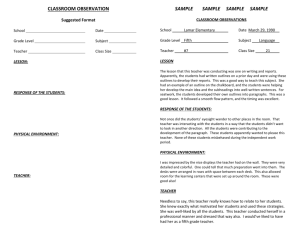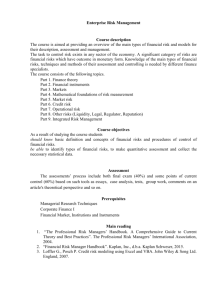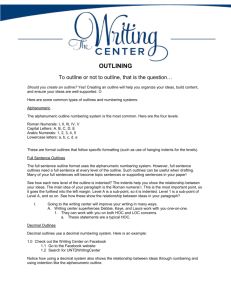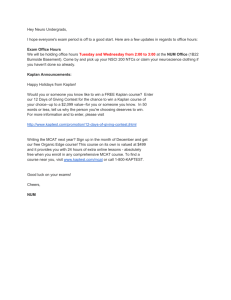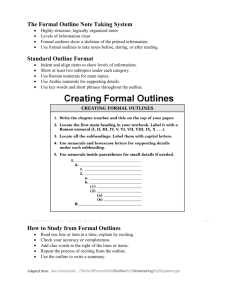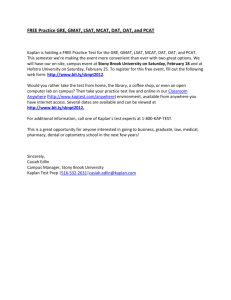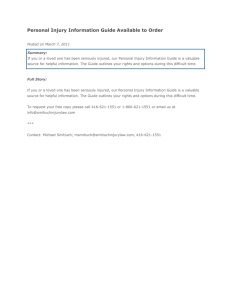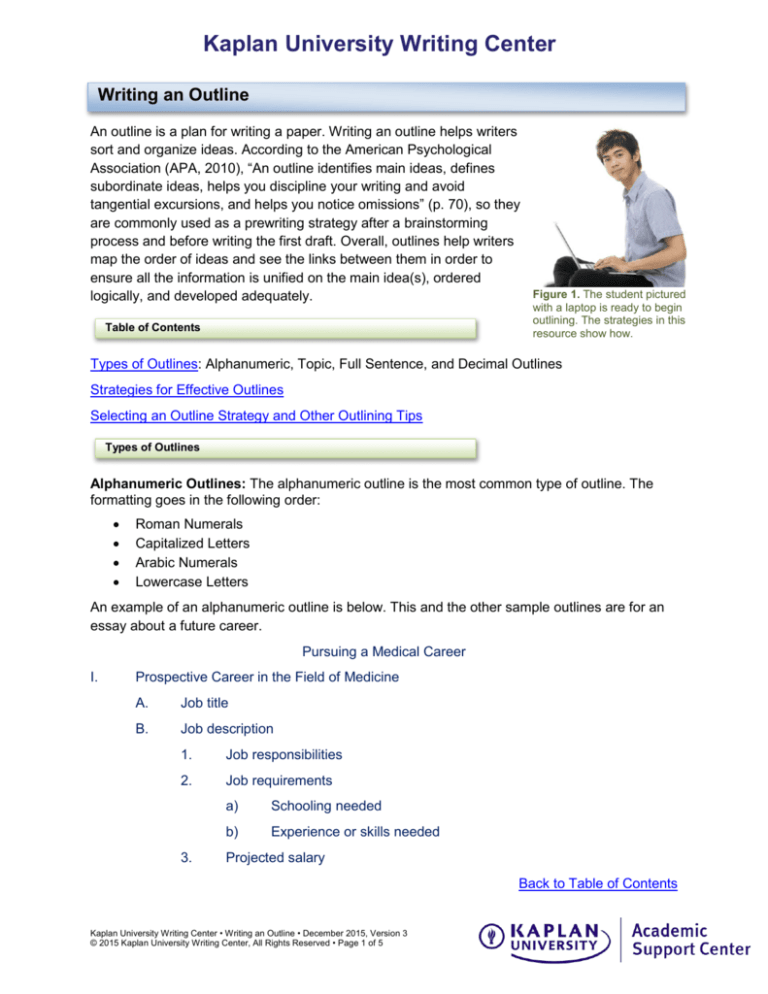
Kaplan University Writing Center
Writing an Outline
An outline is a plan for writing a paper. Writing an outline helps writers
sort and organize ideas. According to the American Psychological
Association (APA, 2010), “An outline identifies main ideas, defines
subordinate ideas, helps you discipline your writing and avoid
tangential excursions, and helps you notice omissions” (p. 70), so they
are commonly used as a prewriting strategy after a brainstorming
process and before writing the first draft. Overall, outlines help writers
map the order of ideas and see the links between them in order to
ensure all the information is unified on the main idea(s), ordered
Figure 1. The student pictured
logically, and developed adequately.
with a laptop is ready to begin
outlining. The strategies in this
resource show how.
Table of Contents
Types of Outlines: Alphanumeric, Topic, Full Sentence, and Decimal Outlines
Strategies for Effective Outlines
Selecting an Outline Strategy and Other Outlining Tips
Types of Outlines
Alphanumeric Outlines: The alphanumeric outline is the most common type of outline. The
formatting goes in the following order:
Roman Numerals
Capitalized Letters
Arabic Numerals
Lowercase Letters
An example of an alphanumeric outline is below. This and the other sample outlines are for an
essay about a future career.
Pursuing a Medical Career
I.
Prospective Career in the Field of Medicine
A.
Job title
B.
Job description
1.
Job responsibilities
2.
Job requirements
3.
a)
Schooling needed
b)
Experience or skills needed
Projected salary
Back to Table of Contents
Kaplan University Writing Center • Writing an Outline • December 2015, Version 3
© 2015 Kaplan University Writing Center, All Rights Reserved • Page 1 of 5
Kaplan University Writing Center
Topic Outlines: A topic outline uses headings and subheadings for each point, each topic
heading and subheading is formed with words and phrases rather than complete sentences.
Choosing a Career
I.
Chosen Career
A.
Career title
B.
Career description
1.
Possible job responsibilities
2.
Requirements to acquire the career
3.
a)
Higher education degree needed
b)
Advancement opportunities within field
Starting and future projected salary
Back to Table of Contents
Full-Sentence Outlines: A full-sentence outline format is the same as an alphanumeric outline,
except that it uses full sentences for each point throughout the outline.
A Career in Medicine
I.
There are many prospective careers in the field of medicine.
A.
One important medical career is registered nursing.
B.
The job description of a registered nurse (RN) varies depending on the facility
and doctor the nurse works with. Generally, a nurse focuses on the care of patients.
1.
RNs have several job responsibilities.
a)
RNs promote good health and prevent illness, administer
medications under the supervision of doctors, and keep records of patient
symptoms and progress.
b)
RNs also educate patients and the public about medical
conditions, treat and help patients in their rehabilitation, and provide
advice and emotional support to patients’ families.
2.
Higher education is required to become an RN.
a)
To be an RN, one must obtain an associate’s or bachelor’s degree
in nursing.
b)
A master’s degree in nursing is also expected at some medical
facilities or for some nursing specialties and for advancement.
3.
The annual projected salary for a nurse can range from $30,000 to
$100,000.
Back to Table of Contents
Kaplan University Writing Center • Writing an Outline • December 2015, Version 3
© 2015 Kaplan University Writing Center, All Rights Reserved • Page 2 of 5
Kaplan University Writing Center
Decimal Outlines
The decimal outline is similar to the alphanumeric outline; however, the decimal outline includes
decimal notation that indicates how every level of the outline relates to one other.
1. Research Careers
1.1. Chose a career
1.2. State chosen career title
1.2.1. Explain career responsibilities
1.2.2. Explain career requirements
1.2.2.1.
Provide educational requirements
1.2.2.2.
Describe potential advancement opportunities
Back to Table of Contents
Strategies for Effective Outlines
Effective outlines are written with attention to word forms and sentence structures. Specifically,
the following elements of writing style are important for creating a coherent and clear outline.
Parallelism
Repeating the grammatical structures of subsequent clauses, phrases, or words creates
coherence (unity and soundness) in writing and improves readability. We call this kind of
intentional repetition “parallelism.” Refer to the Writing Center workshop on editing and
proofreading for sample sentences showing parallel structures. Each of the sample outlines in
this resource also illustrates parallelism. Here’s another example:
Parallel
I.
Choose prospective career.
II.
Provide career responsibilities.
III.
Discuss educational requirements.
In the example, each phrase begins with a present tense verb, so each is parallel in structure. If
one of the verbs was in another form, or if the point began with a noun instead of a verb, the
points would not be parallel making it harder for a reader to see how the ideas link together to
form a logical (coherent) organization.
Not Parallel
I.
Choosing prospective career
II.
Provide career responsibilities.
III.
Educational requirements
Back to Table of Contents
Kaplan University Writing Center • Writing an Outline • December 2015, Version 3
© 2015 Kaplan University Writing Center, All Rights Reserved • Page 3 of 5
Kaplan University Writing Center
Coordination
All the information contained in the first heading should have the same importance as the
information or subtopic in the second heading and third, etc. Similarly, the subheadings should
be equal in importance to one another. In the following example, points I, II, and III are each
main points with balanced importance in the paper. The points with lesser importance, the
supporting details, are given in the next level of the outline:
I.
Research your prospective career.
II.
Evaluate your prospective career responsibilities.
A.
Explain significant responsibilities
B.
Note additional responsibilities required.
Subordination
The information in the headings should be more general, and the information in the
subheadings should be more specific. In the example below, to describe a career would be to
provide an overview or general information whereas stating the job title and explaining the job
responsibilities would be to provide specific details.
I. Describe your prospective career
A. State your job title.
B. Explain your job responsibilities.
Division
Each heading should be divided into two or more parts. For instance, if there is a I, there should
also be a II, and if there is an A, there should also be a B, and if there is a 1, there should also
be a 2 and so on.
I.
II.
Describe your future career.
A.
State the job title.
B.
Explain the job responsibilities.
Evaluate employment forecast for this career.
A.
Discuss hiring trends.
B.
Provide employment/unemployment statistics.
Back to Table of Contents
Kaplan University Writing Center • Writing an Outline • December 2015, Version 3
© 2015 Kaplan University Writing Center, All Rights Reserved • Page 4 of 5
Kaplan University Writing Center
Selecting an Outline Strategy and Other Outlining Tips
When selecting an outline, it is important to consider your purpose for writing an
outline, the audience who will read the outline, and the course and any assignment
requirements for your outline.
Additionally, your specific topic and thesis statement, as well as the number of
supporting points in your thesis, may also help you determine the best outline strategy.
When including research in an outline, every instance of source information requires an
APA in-text citation and a full citation on a references list.
Microsoft® Word has an outlining feature. To access this feature, click on the Home
tab and scroll to the Paragraph settings, and click on the appropriate outline format.
1
2
Figure 2. Microsoft Word Outlines: 1. Select Home tab. 2. Scroll to paragraph settings and select an outline option.
Back to Table of Contents
Kaplan University Writing Center • Writing an Outline • December 2015, Version 3
© 2015 Kaplan University Writing Center, All Rights Reserved • Page 5 of 5

